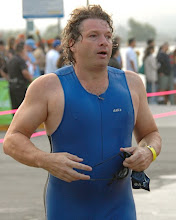I have been riding my bike for several weeks so I know enough about it that I can comment on it and the whole building experience. First, building my bike was totally worth it. Besides the obvious cost-savings, I know so much more about bikes now. I am not afraid to tackle almost any bike repair job and, as an added bonus, I now have more tools than I did before.
As far as the bike goes, I really like it. I am a whole gear faster/stronger than my previous bike. Before, if I would ride some section of road in the fifth cog, now I ride it in the (next-smallest) sixth. I'm guessing that it's because my fit is better. With a nine-month layoff before this, it's not because I'm stronger. My hands no longer get so numb on long rides. The bikes corners very well. In what is probably a combination of titanium and the 25mm tires, the ride is less harsh than my previous bike. Sections of rides that I am very familiar with and know to be bumpy are much less so now.
It does have a few minuses, though. First, my feet are located much closer to the front wheel, which comes into play at very slow speeds if I have to make a severe steer (like turning around on a bike path or the wobbles that happen when you slowly approach a red light, waiting for it to turn green). The tire can bump into my feet if I turn far enough. This is a bit unsettling but since I don't have to steer like that too often, I am managing. The frame has some flex up top. I don't feel any flex if I get out of the saddle to climb but I do notice it on bumpy roads and working hard in the saddle up a climb. Finally, my center of gravity has moved backwards such that I have to make a few adjustments. First, on descents I no longer have to slide my butt back in the saddle; rather, I just lean forward (which really isn't a minus). Second, if I am doing a steep climb I can actually pull on the hoods so hard that the front wheel will come off the ground. If that happens I lean forward or get out of the saddle, which also puts me more forward.
These minuses demonstrate to me the value of a custom frame builder. If I had the $$, I could have taken my fit data to a builder and, while the dimensions of the bike would mostly be the same, a builder (I hope) would have noticed that my feet were too close to the front wheel and made an adjustment there. And would have noticed that the head tube should be tapered and the top tube should be bigger to cut down on flex (for example--I don't know if those are true) . Alas, I don't have a lot of $$ right now so I can deal with these little minuses. Make no mistake, I am very happy with my bike.
Here are some lessons I learned during this odyssey:
- Find the best bike fitter in your area (which is, likely, not some guy in your LBS) and spend the money to get a real fit, preferably before you buy your next bike. It is so worth it.
- Get the right tools for the job. If you are going to build your bike and don't have the tools to do it, prepare to spend money on new tools. Get good ones from a reputable company and don't try to jury-rig something...unless you are a natural handyman (I am not).
- That said, know which LBS you can turn to for advice, parts, and repairs. Even though I did this "myself", I went to Bicycle John's Santa Clarita several times for endcaps, a cable cutter, installation of headset, installation of the bottom bracket, a shifter cable, and even some washers. They were great.
- Cameras are wonderful. Use them when taking things apart (like cassettes) so you can use the pictures for reference when putting those things back together.
- If you don't already have one, for goodness sake get a repair stand.
- If you can afford pro-level gear, get it. It may be twice as expensive as something lesser but if that amount is within your budget, get it.
- Bike assembly and repair really isn't that hard. Once you have the tools, the main thing you need is experience and you only get that by doing so dive right in.
A great experience. Time to go for a ride!
















